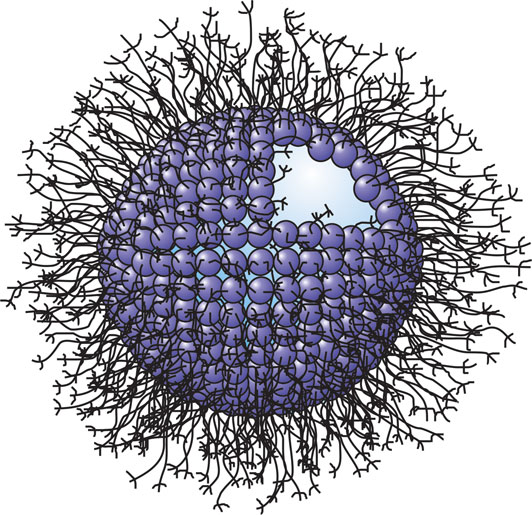Carbon dioxide is readily converted under pressure into a dense liquid or supercritical fluid (with properties ranging from gas-like to liquid-like). Being cheap, abundant, non-toxic and easily disposed of, CO2 is potentially an interesting medium for processing foods, drugs, and chemicals. The snag is that it is a rather uncooperative solvent and dissolves only tiny levels of water, for example.
Chemists have, therefore, been looking at ways to modify the properties of CO2 by adding suitable surfactants (soap-like molecules) that would coax water to disperse within it. These molecules must be chemically attractive to both media, self-assembling into ‘micelles’ which encapsulate the water molecules within the CO2 solvent.

Schematic of a surfactant-stabilised water-in-CO2 microemulsion droplet, stabilised by novel surfactants.
View full-size image
Another goal is to find materials that would thicken CO2, rather as gelatine converts water into a jelly in foods. The modified CO2 could then be used in wells to pump out the last remaining oil or natural gas, currently not recoverable. In the long term, the technology could prove invaluable in carbon-capture schemes to store CO2 underground.
SANS reveals all
Unfortunately, most surfactants show little liking for CO2. Those containing fluorine are CO2 soluble but are both uneconomic and environmentally unacceptable, and so the hunt is now on for more suitable candidates. Julian Eastoe at the University of Bristol and David Steytler at the University of East Anglia have been chemically customising surfactants to make them more CO2 friendly, and – using small angle neutron scattering (SANS) – have been exploring how effectively they disperse water in CO2. SANS can reveal the presence of molecular assemblies such as micelles. The studies were carried out at ISIS in a specially designed cell which kept the CO2 at pressures between 60 and 500 atmospheres – more than 100 times that in a car tyre.
Two chemical strategies were adopted. Taking the structure of a commercial surfactant called Aerosol OT as a starting point, the researchers added three hydrocarbon ‘fingers’ (tertiary butyl groups) to the ends of the chains to make the molecule more ‘CO2- friendly’. The SANS data confirmed that micelles formed. The researchers then made a triple-chain version which turned out to be the most CO2-soluble ionic surfactant to date. Inserting oxygen links into the chains further promoted the CO2-attraction.
This preliminary work successfully points the way forward to unlocking the vast potential of CO2 as a green processing and separation medium.
Prof Julian Eastoe (Bristol University), Julian.Eastoe@bristol.ac.uk
DC Steytler (UEA), S Gold (Astra Zeneca), S Rogers (DIAMOND)
Research date: December 2007
Further Information
Hydrocarbon surfactants for CO2: an impossible dream?, J Eastoe, S Gold and DC Steytler, Current Chemistry, Aust. J. Chem. 60 (2007) 630.
Surfactants for CO2, J Eastoe, S Gold and DC, Steytler, Langmuir 22 (2006) 9832.
Designed CO2-philes stabilize water-in-carbon-dioxide microemulsions, J Eastoe et al. Angew. Chem. Int. Ed. 45 (2006) 3675.
